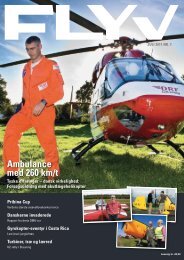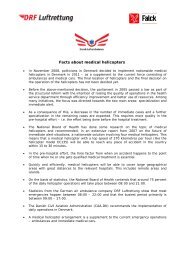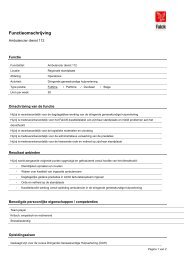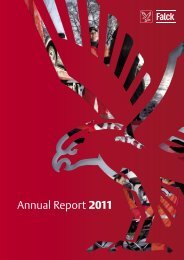Annual Report 2010 - Falck
Annual Report 2010 - Falck
Annual Report 2010 - Falck
You also want an ePaper? Increase the reach of your titles
YUMPU automatically turns print PDFs into web optimized ePapers that Google loves.
44 <strong>Falck</strong> <strong>Annual</strong> <strong>Report</strong> <strong>2010</strong> | Management review<br />
Financial risks<br />
Interest rate and foreign exchange risk<br />
The Group’s interest rate risk is mainly affected by the Group’s<br />
overall financing. Based on the current market situation, the<br />
Executive Management Board and the Board of Directors have<br />
decided that the financing is to be based on short-term interest<br />
rates.<br />
Interest collars covering DKK 1,709 million with a floor of 3.25%<br />
and a cap of 5.5% have been entered into to hedge interest rate<br />
risks.<br />
Credit institutions, floating-rate loans<br />
DKK million <strong>2010</strong> 2009<br />
DKK 2,271 1,595<br />
EUR 855 999<br />
USD 249 249<br />
Other - 30<br />
Total 3,375 2,873<br />
The Group is therefore sensitive to fluctuations in market interest<br />
rates, and a fluctuation by 1% would change the Group’s<br />
interest expense by DKK 13 million as the market rate for the<br />
current year is below the floor of the interest rate collars. Without<br />
an interest rate collar, a fluctuation by 1% would change the<br />
Group’s interest expense by DKK 34 million.<br />
Sensitivity analysis, market-rate fluctuations of 1%<br />
DKK million <strong>2010</strong> 2009<br />
DKK 7 7<br />
EUR - 1<br />
USD 2 2<br />
Total 9 10<br />
The Group monitors developments in market interest rates closely<br />
in order to be able to react if the market situation changes.<br />
The exchange rate exposure of the Group’s transactions is<br />
limited since subsidiaries outside Denmark largely operate in<br />
local currencies, to the effect that the revenues and most of<br />
the expenses of the individual subsidiaries are denominated in<br />
the same currency. The main exchange rate exposure faced by<br />
the Group relates to the translation into Danish kroner of the<br />
financial results and equity of subsidiaries.<br />
In the event of a concurrent fall in all exchange rates by 1%, this<br />
would reduce revenue by DKK 31 million, EBITA by DKK 3 million<br />
and equity by DKK 17 million.<br />
In the event of a change in the DKK/EUR exchange rate by 1%,<br />
the Group’s debt would change by DKK 9 million, which would<br />
be recognised in the income statement. Fluctuations in the<br />
DKK/USD exchange rate have no impact on the income statement<br />
or equity as the Group’s debt is hedged.<br />
The Group regularly assesses its foreign exchange risks in order<br />
to determine whether the exposure should be hedged by loans<br />
in the same currencies or forward exchange contracts.<br />
Credit risk<br />
When entering into significant contracts, the Group makes a<br />
credit assessment of the customer in order to assess the potential<br />
credit risk. Trade receivables are monitored and evaluated<br />
on a continuing basis in order to assess any need to make<br />
provisions for bad debts.<br />
The Group’s credit exposure to large customers is considered<br />
low as the Group’s large customers are, to a great extent, public<br />
authorities.<br />
Subscription sales to private and corporate customers are not<br />
deemed to involve material risks to the Group as the amounts<br />
are small for the individual subscriptions, and general as well<br />
as individual write-downs are made for anticipated bad debts.<br />
As at 31 December <strong>2010</strong>, receivables from such subscriptions<br />
totalled approximately DKK 76 million (2009: DKK 45 million).




